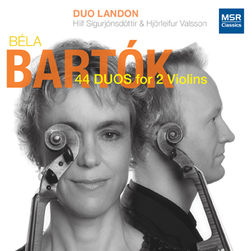Among 20th-century composers, Bártok stood out for his ability to write pedagogical works that contained musical substance, such as the 44 violin duos, whose attractive folkloric character, rhythmic inventiveness, and unforced canonic writing transcend their primary didactic purpose. Like Andras Keller and Janos Pilz on ECM, Hlíf Sigurjónsdóttir and Hjórleifur Valsson group the pieces according to the composer’s suggested order. They generally play in a louder, less nuanced, and at times more aggressive style that is closer to Angela and Jennifer Chung on Harmonia Mundi, but with more consistent intonation.
Compare the Pizzicato No. 43 for starters, and notice how their stentorian, big-boned legato treatment of the No. 42 Scherzo contrasts to Keller and Pilz’s lighter, detached interplay. Sigurjónsdóttir and Valsson’s broad, proclamatory phrasing of the Wedding Song (No. 29) also differs from Keller and Pilz’s gentler conversational inflections. At first No. 22 seems too slow to convey the music’s impression of a mosquito buzzing nearby, but the deliberate tempo gives extra clarity and breathing room to the composer’s cross-rhythmic effects. Collectors who know the Perlman/Zuckerman interpretations with their full-bodied, vividly detailed sonics will find a modern-day counterpart via Sigurjónsdóttir and Valsson’s hearty assurance. That said, I prefer the ECM edition’s superior idiomatic character, while hoping that its finest stylistic antecedent featuring Sándor Vegh and Albert Lysy will reappear on CD.
































